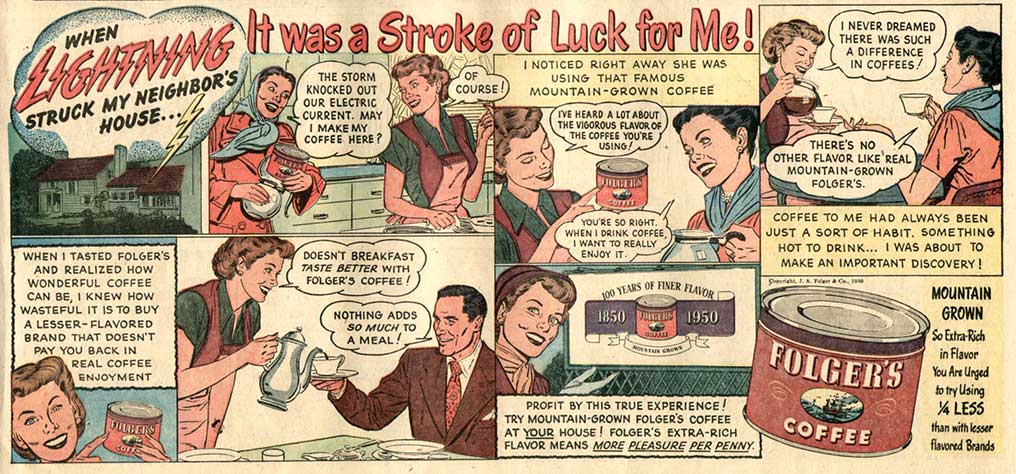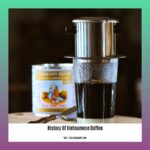Grab a cup and settle in for the captivating story of Folgers Coffee! We’re going to dive into the fascinating history of this coffee giant, from its humble beginnings to its present-day dominance. We’ll sip on some intriguing facts, learn about the secrets behind its success, and uncover the mysteries surrounding Folgers’ heritage. So, relax, enjoy the aroma, and prepare to be amazed by the journey of this iconic coffee brand.
History of Folgers Coffee
Ever wonder how Folgers became a kitchen staple across America? Pour yourself a cup and let’s dive into the history of this iconic coffee brand!
From Humble Beginnings to a Household Name
The story begins in the 1600s when the Folger family decided to leave Norwich, England, and seek their fortune in the New World. Little did they know their name would become synonymous with coffee centuries later!
Fast forward to 1850s San Francisco during the height of the California Gold Rush. Green coffee beans were the norm, requiring people to roast and grind them at home. Recognizing an opportunity, the Folger family established the Pioneer Steam Coffee and Spice Mills. This move was revolutionary! They were among the first to sell pre-roasted and ground coffee, making it much easier for people, especially busy gold miners, to enjoy their daily brew.
Rise to Coffee Stardom
In the early 1900s, Folgers expanded, bringing its coffee to Texas and Kansas City. A savvy businessman named Frank P. Atha played a key role in this expansion, using creative marketing tactics to make Folgers a recognizable name.
Then came a game-changer in 1963 when Procter & Gamble acquired Folgers. This move catapulted the brand to the very top of the coffee market, even surpassing the well-established Starbucks.
Revolutionizing Coffee Consumption
Before Folgers, drinking coffee was a multi-step process. You’d have to buy green coffee beans, roast them to your liking, grind them up, and then, finally, brew your coffee. Folgers changed all that by offering pre-packaged, ground coffee at an affordable price. This convenience factor was huge, turning coffee from a special occasion drink into an everyday essential for millions of Americans.
The Legacy of Folgers
There’s no doubt Folgers has left its mark on coffee culture, particularly in America. By being pioneers in pre-ground coffee, they made it so much easier and quicker for people to enjoy a cup.
Even today, Folgers remains a household name, bringing to mind images of classic American breakfasts and cozy mornings. And who could forget their catchy jingle, “The Best Part of Wakin’ Up”? It’s practically a part of American pop culture!
From its humble beginnings in San Francisco to becoming a global brand, Folgers’ story is one of innovation, risk-taking, and understanding what consumers want. They’ve certainly changed the way generations of Americans experience their morning coffee.
Where Did Folgers Coffee Originate?
We know Folger’s coffee is a big deal, but how did it all begin? Let’s rewind to the mid-1800s during the California Gold Rush. San Francisco was bursting at the seams with fortune seekers. Amidst the chaos, a small company called Pioneer Steam Coffee and Spice Mills emerged. This wasn’t your average mill; they were among the first to roast and grind coffee before selling it, a game changer for busy miners who wanted their caffeine fix without the fuss.
Enter James A. Folger, a carpenter with a keen eye for opportunity. He saw the potential in this coffee business and invested his savings. By 1865, he was a full partner, and the company was renamed J.A. Folger & Co.
The Folger family wasn’t just lucky; they were dedicated to quality, believing in a good cup of coffee. James A. Folger II followed in his father’s footsteps, expanding the business. Later, Frank P. Atha, a marketing whiz, helped make Folger’s a household name. By 1963, they were the top dogs, selling more pre-ground coffee than anyone else in the United States!
Here’s a recap of Folger’s journey:
| Milestone | Year |
|---|---|
| Pioneer Steam Coffee & Spice Mills | 1850 |
| James A. Folger becomes partner | 1865 |
| Folger’s becomes a national brand | 1963 |
Folger’s journey is a testament to the fact that with some luck, a lot of hard work, and a commitment to quality, even a simple cup of coffee can become a legendary success story.
Which Coffee Is Older: Maxwell House or Folgers?
Both Maxwell House and Folgers are giants in the coffee world, but which one has been around longer?
Folgers takes the prize for being the elder statesman of the coffee world. They started in 1850 in San Francisco during the California Gold Rush. James A. Folger, a pioneer seeking his fortune, saw the real gold mine was coffee.
Maxwell House came along a bit later in 1892, down south in Nashville, Tennessee. They took their name from the Maxwell House Hotel, a place known for serving a darn good cup of coffee.
So, while Maxwell House has a cool story, Folgers wins for longevity by a good 42 years. It’s amazing to think about these brands lasting for so long and becoming such a big part of our morning routines.
What Are Some Fun Facts about Folgers?
There’s a lot more to Folgers than meets the eye:
- Gold Rush Roots: The Folgers’ story began in the 1600s when the family left England to chase the dream of gold mountains. Turns out, their fortune wasn’t in nuggets, but in coffee beans!
- America’s Cup Fuel: Folgers has fueled the sailors in the prestigious America’s Cup yacht race since 1987.
- The Frank Atha Factor: Frank Atha, a salesman extraordinaire, believed in the power of Folgers and helped make it a household name.
- Pioneers of Pre-Ground: Folgers revolutionized coffee consumption by making pre-ground coffee available to everyone.
- Radio Days: In the 1950s, Folgers had a radio show called “The Five-O-Clock Follies” featuring live music and jingles.
- Jingle That Sticks: The iconic “The Best Part of Wakin’ Up” jingle, playing since 1984, is practically a morning anthem for coffee lovers.
Here’s a little Folgers fact sheet:
| Fact | Details |
|---|---|
| Founded | 17th century |
| Claim to Fame | Made ground coffee widely accessible |
| Key Figure | Frank Atha, legendary salesman |
| Fun Fact | Official coffee of the America’s Cup |
| Most Recognizable Feature | The “Best Part of Wakin’ Up” jingle |
Folgers is more than just a can of coffee; it’s a story of ambition, innovation, and a whole lot of caffeine. As long as there are coffee lovers, Folgers will likely be there to fuel their mornings.
What Is the Oldest Coffee Brand in the US?
What’s more American than a good cup of joe in the morning? But which coffee brand has been around the longest? The title of America’s oldest coffee roaster likely goes to Folgers.
Pinning down the absolute oldest company with 100% certainty is difficult, as records from back then weren’t always accurate. However, the evidence suggests Folgers is a top contender. They first started in San Francisco in 1850, during the Gold Rush, as the “Pioneer Steam Coffee and Spice Mills.”
Their innovation was pre-roasting and grinding coffee beans, a revolutionary idea that allowed people to make coffee without needing specialized equipment. This innovation took the coffee world by storm.
By 1963, Folgers had become the most popular pre-ground coffee in the United States, holding onto that top spot ever since.
And let’s not forget their iconic jingle, “The Best Part of Wakin’ Up!” Since 1984, it’s become almost as famous as the coffee itself.
While we can’t be entirely sure if there’s an even older coffee brand hiding in some dusty history book, it seems Folgers is a safe bet for the oldest in the US. Their story is a blend of innovation, coffee beans, and a catchy jingle that’s stuck with us through the years.
Is Folgers Coffee Real Coffee?
Folgers is real coffee. It might not be the fanciest bean in the world, but it’s made from roasted coffee beans, just like any other cup of joe. It’s simply been through more processing for convenience.
One reason people question Folgers is its affordability. But don’t let the price tag fool you. Folgers has been around since the Gold Rush, building a reputation for a solid cup of coffee. They source decent beans and have strict rules about roasting and grinding.
Folgers is also always evolving. They know tastes change and are not afraid to try new things, from instant coffee crystals to flavored coffees and K-cups.
While Folgers might not win any fancy barista championships, when you brew a cup, you’re getting real coffee. For many, that’s perfectly okay.
Is Folgers Really from New Orleans?
While Folgers embraces a New Orleans vibe, their story begins on the other side of the country. Folgers started roasting coffee beans in 1850 in San Francisco, California. They didn’t move their operations to New Orleans until the mid-1960s. Why? New Orleans was (and still is) a major hub for the coffee trade.
Even though Folgers wasn’t born in New Orleans, it’s become part of the family. They have two large coffee plants in the city, employing many locals and playing a significant role in the community. Folgers is known for supporting New Orleans through charities and events, from education to disaster relief.
Interestingly, while Folgers roasts and packs coffee in New Orleans, the beans come from around the world. It’s a global coffee party, all coming together in the Big Easy for that final Folgers touch.
So, is Folgers really from New Orleans? Their history might say otherwise, but their connection to the city is undeniable. They’ve embraced the culture, invested in the community, and become a familiar face in the heart of Louisiana.
Where Did Chicory Coffee Originate?
Chicory coffee, a unique brew, has a story to tell. It all started in France in the 1800s during a coffee shortage. People craved their caffeine, and someone had a clever idea: the chicory root, a humble plant related to the dandelion.
While there’s debate on who deserves credit for turning this root into a coffee substitute, some believe it was two Frenchmen, M. Orban and M. Giraud. They experimented with roasting and grinding chicory root, blending it with coffee beans. This new drink wasn’t coffee, but it had a similar vibe with a bitter edge.
Chicory coffee became a hit, especially in Belgium, Denmark, and Germany. It was affordable, versatile, and people loved it.
French settlers brought chicory coffee to New Orleans, and the city, known for its coffee culture, embraced it. After the Revolutionary War, New Orleans became a major coffee hub, and chicory coffee became a local legend.
Today, chicory coffee is still a big deal in New Orleans—a tradition and a taste of history often enjoyed with milk and sugar. Chicory coffee has also found fans worldwide, who appreciate its unique flavor and fascinating story.
What Was the First Coffee House in America?
Let’s travel back to 1689 and stroll through the busy streets of Boston. You catch a whiff of something rich and aromatic—coffee! The aroma leads you to the London Coffee House, the first establishment in America dedicated to this then-exotic brew.
The London Coffee House was the place to be seen, catch up on gossip, and even strike a business deal.
While some say coffee beans arrived in America as early as the 1640s, coffee didn’t truly take off until the London Coffee House opened. Its popularity paved the way for coffee to become beloved across the colonies.
Choosing coffee over tea at that time was a mini-rebellion. America was still under British rule, and the British loved their tea!
Let’s not forget Dorothy Jones, a trailblazer who became a licensed coffee trader, showing that coffee wasn’t just a “man’s business.” Her work was crucial in the growth of the American coffee trade.
It’s fascinating how a single coffee house in Boston played such a significant role in shaping American culture and its love affair with coffee.
Want to dive deeper into this fascinating history? Check out this article for more:
When Did Smuckers Buy Folgers Coffee?
On June 4th, 2008, Smuckers made a big splash in the coffee world, buying Folgers from Procter & Gamble (P&G) for $3.3 billion! This was a huge move.
Why was Smuckers so keen on Folgers? Smuckers already had breakfast products like jams and jellies. Adding Folgers was a perfect pairing—toast and coffee!
This deal allowed P&G to focus on other products. Sometimes, companies streamline operations, and selling a brand like Folgers can help them grow.
This 2008 deal still resonates today, showing how business deals can significantly impact, even years later. It reminds us that even giants like Smuckers and P&G adapt and change to stay on top.
What Does “Folger” Mean?
It’s interesting to delve into the meaning of “Folger.” Words like “folk” and “following” share a connection with “Folger,” originating from old Germanic languages, signifying a sense of community and loyalty.
Historically, “Folger” had various uses. Sometimes it was a friendly nickname. It could also be a more serious title, indicating someone loyal to a leader or acting as their legal representative.
“Fulcher” is a variation found in some regions, reinforcing the idea that the word was about social roles and connections.
It’s intriguing to consider how this word was used throughout history! Language evolves, but it’s fascinating to see remnants of the past in the words we use today.
Internal Links:
For an in-depth exploration of Frankoma Pottery’s history, follow this link. To learn more about the history of Gideons International, click here. For a comprehensive look at the history of Gruene, Texas, visit this page.
- Crypto Quotes’ Red Flags: Avoid Costly Mistakes - June 30, 2025
- Unlock Inspirational Crypto Quotes: Future Predictions - June 30, 2025
- Famous Bitcoin Quotes: A Deep Dive into Crypto’s History - June 30, 2025

















2 thoughts on “Brewing an Empire: The Story of Folgers Coffee”
Comments are closed.